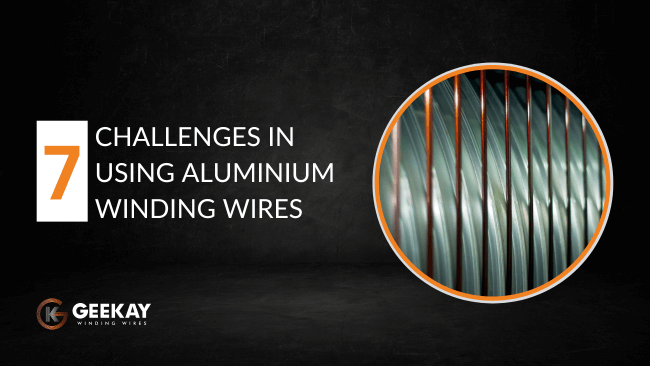Aluminium is a good conductor widely used in power transmission and distribution lines. It is lightweight, malleable and ductile. All the more, it is available in abundance making it cheaper than other good conductors like copper, silver and gold.
These properties of aluminium as a metal make it a good candidate to make winding wire. But the truth is that even though it is a good conductor, it may not be the best choice for some winding wire applications. Here is why –
Disadvantages of Enamelled Aluminium Winding Wires-
1. Size –
Though aluminium is a good conductor, it is not as good as copper. It offers higher resistance to the electricity flow.
Resistivity of Copper at 20 °C is 1.68 x 10-8 Ohm
Resistivity of Aluminium at 20 °C 2.65 x 10-8 Ohm
The ratio of the resistance of Aluminium to Copper comes to (2.65 x 10-8) / (1.68 x 10-8) = 1.6
Hence to get the same conductance, the size of the aluminium winding wire must be 25-30% more than copper winding wire of equivalent length. Or in other words, for the same application, the diameter of the aluminium winding wire or the number of turns must be much more than that when using a copper winding wire.
This makes the coil bulkier, making aluminium magnet wires unsuitable for applications requiring compact dimensions.
2. End Connections –
The enamel must be removed and soldered or crimped to make end connections of winding wire.
Aluminium as a metal gets oxidised fast when exposed. And this oxide layer has an insulating nature. So to make the terminal connections with aluminium winding wire, it needs to penetrate the oxide layer as well.
At the same time, the connection should be sealed airtight to prevent it from getting oxidised further. For this high-pressure piercing crimp connectors are the most reliable, however for smaller sizes in aluminium (less than 32 SWG or 0.27mm) crimping is very difficult and leads to a lot of in-process rejection and rework. In this case, we can use self-solderable wires or special processes for soldering which are also accepted as reliable.
3. Prone to Corrosion –
Aluminium is highly susceptible to corrosion. The oxide layer thus formed on the Aluminium surface due to corrosion is an insulator.
In Aluminium winding wires corrosion can thus reduce the effective inline diameter of the conductor. And the additional resistance causes heat development and ultimately insulation failure. Corrosion for a longer duration can lead to field failure resulting in equipment failure.
This even calls for frequent maintenance of the aluminium wound motors.
Thus, aluminium winding wires are not recommended in damp or marine environments like Submersible pumps.
4. Thermal Conductivity
The thermal conductivity of aluminium is less than copper. This makes Aluminium magnet wires more prone to high hot spot temperatures, which can lead to shorter operating lives.
Aluminium has a higher thermal expansion coefficient and expands approximately one-third more than copper when put under heat. These thermal qualities make the aluminium windings wire less efficient. And these could very well translate to higher operating costs.
All these reasons make aluminium winding wires unsuitable for high-temperature applications.
5. Winding Speed-
Aluminium winding wire has poor tensile strength making it brittle. Though it has high windability, extra care is required while handling them. Hence winding speed is lower than that of copper. This could slow down your manufacturing process and if not, increase scrappage.
Aluminium winding wires thus operate on slightly lower winding speeds.
6. Customer Satisfaction
Since the conductance of aluminium is low, the energy efficiency is also less. This can bring down the energy rating of your products and translates into higher operating costs for consumers. Thus, not satisfying the demands of energy-conscious consumers.
The lifespan of aluminium winding wires is less than that of copper. Apart from that, they call for frequent maintenance. This can hinder providing longer warranty periods for your products.
Moreover, aluminium wound appliances may produce more noise during operation than copper wound ones. All these may affect customer satisfaction with your products.
7. Cost
The cost advantage is definitely there but it gets partly offset by lower winding speeds and a slight loss in operational efficiencies. Also, since the diameter of the aluminium wire to be used is around 30% more, the consumption is approximately half of the copper and not 1/3rd which is sometimes expected due to the 1/3rd density of aluminium vis-à-vis copper.
Given the challenges, copper is a better conductor than aluminium for winding wires. Having said so, it is very much possible to match the power performance of a motor wound with aluminium wire to one wound with copper wire. Since aluminium winding wire technology is relatively new, its usage is growing rapidly and currently limited to very few applications.
When to use Enamelled Aluminium Winding Wires
Aluminium winding wire can be used in places where efficiency and volume are not benchmarks. For example when motors have to work occasionally or for a short period of time like in the case of some home appliances like a food processor or mixer grinder. [Read More: Growing Use of Aluminium Winding Wires in Home Appliances]
They are also suited for low-weight and larger-diameter applications like large motors and transformers in industrial applications.
The quality of aluminium winding wire can impact the life and performance of the application. Hence it is ideal to go for a winding wire manufacturer following strict quality protocols. Geekay Winding is an established copper and aluminium winding wire manufacturer.
Check out our aluminium and copper winding wire range and contact us with your specifications for a sample.


